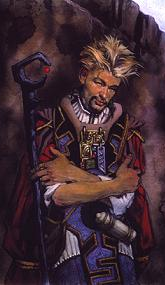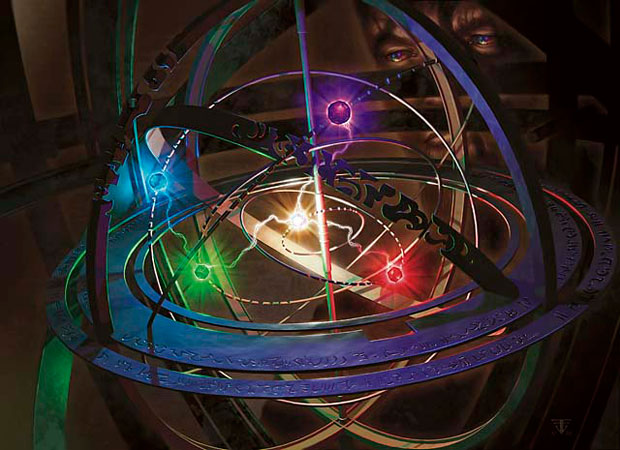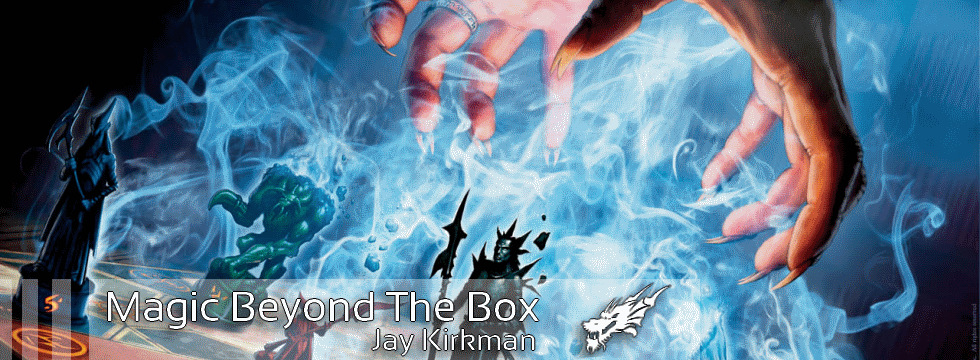Are you a Quiet Speculation member?
If not, now is a perfect time to join up! Our powerful tools, breaking-news analysis, and exclusive Discord channel will make sure you stay up to date and ahead of the curve.
 The reasons players begin to look at the world of cubing are as varied as the reasons why people play Magic in the first place. Commonly, cubing represents the opportunity for a player to create a little world of their own from their favorite sets and cards that they can share with their friends. For others, it's a chance to put on the designer's or developer's cap and construct a finely-balanced experience that explores themes and mechanics in the different colors. Still more relish the simple prospect of drafting over and over again without having to buy boosters each time.
The reasons players begin to look at the world of cubing are as varied as the reasons why people play Magic in the first place. Commonly, cubing represents the opportunity for a player to create a little world of their own from their favorite sets and cards that they can share with their friends. For others, it's a chance to put on the designer's or developer's cap and construct a finely-balanced experience that explores themes and mechanics in the different colors. Still more relish the simple prospect of drafting over and over again without having to buy boosters each time.
As with other alternative formats, cubing has paid its dues on the sidelines before coming to prominence, and there is a fairly established body of literature on the subject (including here at Quiet Speculation). Unfortunately for the novice, much of that literature tends to assume you have some experience with cubing; articles with actual, hard numbers tend to be much less common. This is understandable as there is no 'right' way to build a cube. They can be highly subjective in nature: tribal cubes, power cards cubes, all-rares cubes (and all-commons cubes) are relatively commonplace in the format. But any area where there is no defined 'good' but plenty of opportunity for 'bad' engenders an uncertainty that can be off-putting.
That was me when I built my first cube. I had to draw upon a combination of guesswork, consensus of the published 'experts', and dead reckoning to put it together. Unsurprisingly, I was uncertain about the outcome. Was one color much more powerful than the others, but it wasn't readily obvious? Was I unwittingly sabotaging someone's chances by my selection of cards? When we did our first draft and mono-Black aggro won the day, I had to wonder: Was it because of the player's skill, a bit of luck, or was my cube slightly skewed in that direction, giving the player an unfair advantage?
At last it dawned on me that many of the factors I worried about were the same things that Wizards R&D worry about too, and they've got a lot more minds and experience to devote to the matter. Could a solid 'starter cube' be built by reading the signs they're already telling us? Is the blueprint already out there, hidden in the card pool, that would give us a solid framework upon which to build our cube?
That's indeed the case. If you've been wanting to build your own cube but have been a little intimidated by wanting to 'get it right,' you've come to the right place.
The Standard Cube
Most cubes tend to liberally dip into the length and breadth of Magic's history to find some of the best and most interesting cards ever printed. Undoubtedly these are fun to both play and make, but these tend to be more advanced constructions. (If you're curious to see the thought processes that go into the construction of even the most basic of these time-spanning cubes, you should check out the superb Gathering Magic's "Community Cube" articles by Adam Styborski.)
For our purposes, we want to stick to something that's a little simpler: Standard. There are several reasons to do this. First, since it's a smaller card pool it makes the cube much easier to create. Second, these cards are readily available and generally inexpensive, just the ticket for those who want to get their feet wet in the format but don't want to make a serious time and money commitment if they end up dissatisfied.
Finally, it gives us a very nice snapshot in time using cards that were intended to be played alongside each other. Although R&D doesn't catch everything (famously missing the Splinter Twin and Deceiver Exarch combo), their 'Future Future League' of playtesting ensures that while designed seperately, card sets aren't released in a vacuum. This also ensures that the cube will have some depth in the sets it is representing- players will get a sense of what the environment was about (what it offered and valued) by including more than just a scant handful of the 'best cards.'
Indeed, historical-minded builders could well take the same approach here to most any two-year period of time and build a similar 'Standard snapshot' cube. A '2003 Edition' might pull cards from Odyssey Block (Odyssey, plus Torment and Judgment), Onslaught Block (Onslaught, plus Legions and Scourge), along with, say, 7th Edition or 8th Edition to tie it all together.
Building our first cube out of Standard also gives us another advantage: our structure is already in place right there in front of us. Advanced cubers often have a laundry list of considerations they have to take into account when designing their cube. For instance, is each color properly represented, in terms of its flavor or abilities? And is there the right balance of creatures and noncreatures? Luckily for us, Wizards has already done this with each set we'll be looking at. By looking at the numbers, we can create a very solid blueprint for what we need to build.

Defining the Colors
To a certain degree, any cube nearly builds itself. You know that you have five colors to balance, so each of these must have an equal representation in your card pool. Only once has Wizards ever heavily skewed the color balance: 2002's Torment was heavily skewed towards Black, and that was "balanced" against White and Green overflowing with the follow-up Judgment. The real x-factor comes in the way of cards outside the colors: nonbasic lands and artifacts.
Naturally, the proportion of these cards is defined by their environment. The "land matters" Zendikar block had a generous complement of nonbasic lands: a full thirty-six of them. Scars block? Just nine. Similarly, Scars boasts almost five times as many artifacts as Zendikar did (182 to 38). Here's where a bit of a judgment call is needed. Because nonbasic lands trend the highest in rarity of any card type outside of planeswalkers, they can distort the numbers a bit if we simply add all nonbasic lands and artifacts together and adjust it against how many cards each color gets. While remaining true to our overall goal, it's easier to make a sweeping statement that says "artifacts and nonbasic lands will be lumped together into a sort of 'sixth color,' getting the same number of card slots as any of the other five' and go from there.
Now that we've defined our colors, we next want to look at the size of the cube. Cubes generally tend to come in three sizes: 360, 450, and 540 cards. Remember, an optimal draft environment consists of eight players each opening forty-five cards (three booster packs). That's where 360 comes from (8 times 45). What about 450? And 540? These larger builds are there for variance and diversity. If a cube is 360 cards, a table of eight players will open every card in the cube. Each player can be certain that someone has picked every other rare. By upping the cube size, you add a welcome element of uncertainty. Is that Steel Hellkite in someone's pack, or in one of the leftovers. There's only one way to find out!
Crunching the Numbers
For our purposes, we'll be looking to build a 450-card cube. This translates into 30 boosters' worth of cards, divided into the following commonalities: 30 rares, 90 uncommons, and 330 commons. We'll be keeping costs (and "swinginess") down by excluding mythics, though they could easily be inserted in place of one rare per color (plus a nonbasic/artifact). But commonality is something we'll worry about when the time comes to actually select the cards. For now, we want to build that blueprint, and a 450-card build means that each color gets to have (450 divided by 6) 75 cards to represent it. Of course, while each color is designed to be balanced against one another, that doesn't mean that they do so in an identical fashion.
Indeed, the amount of the different card types, creature and noncreature spells alike, goes a long way at establishing that color's own flavor and identity. It's our goal to preserve as much of this as possible. That means taking a hard look at each color specifically, and determining proportions. We all know that Green is creature-heavy, but knowing exactly how heavy is a very different matter.
As players, we have an understanding of the game's themes. Sometimes we need the comfort and reassurance of hard numbers to give structure and form to what we know to be true. This can be a painstaking process, but luckily we've done all the work for you. After digging around with Gatherer and crunching the numbers across all eight sets we're including, here's what we found.
A quick note on methodology. We used Gatherer to compile the numbers, and looked at each block or set individually to find out how many card slots were dedicated to each group (White creatures, Black sorceries, etc). Simply selecting Format: Standard is misleading because cards that have appeared in multiple sets in the current enviroment (from Doom Blade to Day of Judgment) will only be counted once. Additionally, for reasons stated above,the card type of planeswalker has been excluded from our search, as have multicolor cards.
White: Green is surely the creature colour, but who knew just how close White came to equaling it? White has a sizable portion of its might tied up in bodies (150 cards), and is equally strong in both instants (44) and enchantments (38). Sorceries are few and far between, with only 16 cards of this type.
Blue: As you might expect, Blue is the weakest colour when it comes to creatures (131 cards), though not as weak as some might think. It's not surprisingly the strongest colour for instants (56), perfectly comfortable with enchantments (35), and middle of the pack with sorceries (27).
Black: Black offered up some surprising results. Although we often think of Black aggro strategies as demanding lots of creature options, Black is fairly average with them (141 cards). It's real edge? Sorceries, with a lion's share of 54! Those who favor instant-speed options over their slower cousins are really missing out on a key element of Black's flavor here as there are only 29 instants in this color, easily the worst of any of the colors. Credit cards like Doom Blade and Dismember for letting Black instants punch well above their weight in terms of impression. As for enchantments, Black is solidly average (28).
Red: Red is a bit of a funny color when it comes to identifying its strengths and weaknesses based on card type. It leads in only one category (enchantments) but for having the fewest (23). It's fairly creature-poor (137), second only to Blue, and also second-lowest in instants (41). It makes up for this, however, by being heavy on sorceries (47).
Green: Creatures and combat tricks, right? Not an entirely unfair assessment; Green is blessed with both (a leading 153 critters, and second-place with 49 instants). Consequently, it's rather poor with sorceries (only 23), and boasts the second-fewest enchantments (25).
Nonbasics/Artifacts: We have an abundance here thanks to the back-to-back releases of Zendikar block and Scars block, so there should be little shortage when it comes to options. Since we want to keep the look and feel of Standard, we've broken down this class a little further to give you the 'right' number of artifact creatures and equipment.
So now we have the basic framework of a Standard, 450-card cube. It's said that no plan survives first contact with the enemy, and it's no different here. You should feel comfortable fudging the numbers if there's one extra creature you really want to get in for Blue, for instance. The important things are that the color balance is maintained, and each color gets the same number of rares, uncommons, and commons. In other words, each color keeps a fair shake of things.
Next time, we return to the world of cubing to take a look at the actual cards and tropes (removal, milling, etc) available to each of the colors, individual rarities, and begin to cut down to a final list. While numbers are numbers, the selection process itself will be a highly subjective experience, and we'll find some numbers in surprising places to help us on our quest. See you then!












In most Standard formats, I'd totally agree with giving artifacts/nonbasic lands their own section that was the same size as the other.
In this Standard environment, I think that would be a grave mistake. The two blocks are built around…artifacts and lands. I think that you should, in this case, double that section if possible, cutting each of the other sections down slightly to compensate.
That's a great point. Although doubling is statistically too much, we can revise the numbers to give a much more accurate representation. I'd done it this eway to keep it relatively simple, but having laid a foundation here there's no reason I can't revisit it and go a bit deeper in that direction. I'll make this part of the next article, thanks for the comment!
This is actually a really cool idea, though. I've begun building a few cubes before and given up because of the incredibly overwhelming number of options. This is a great way to just start somewhere. Nothing saying you can't start adding other blocks in one at a time later, either.